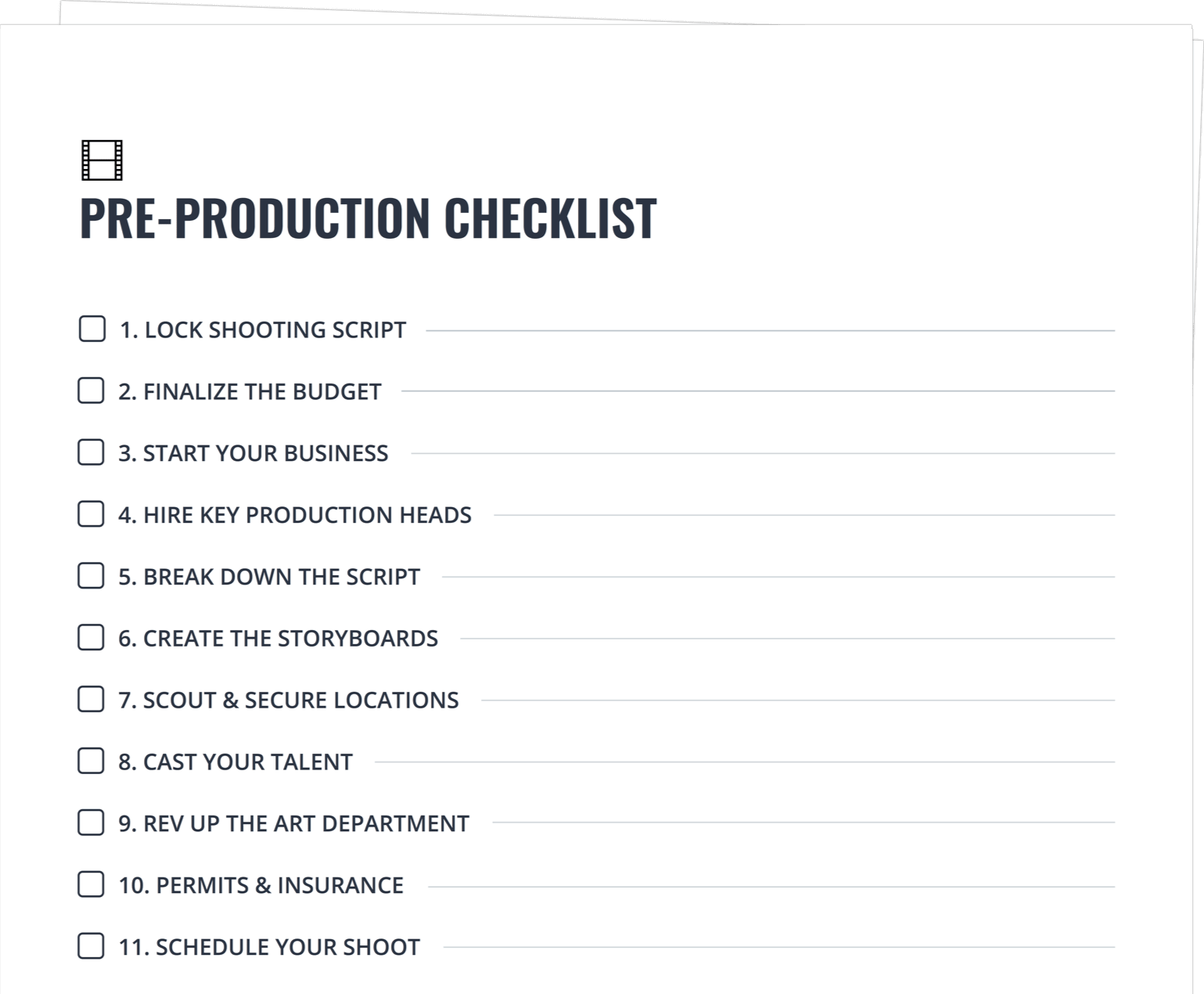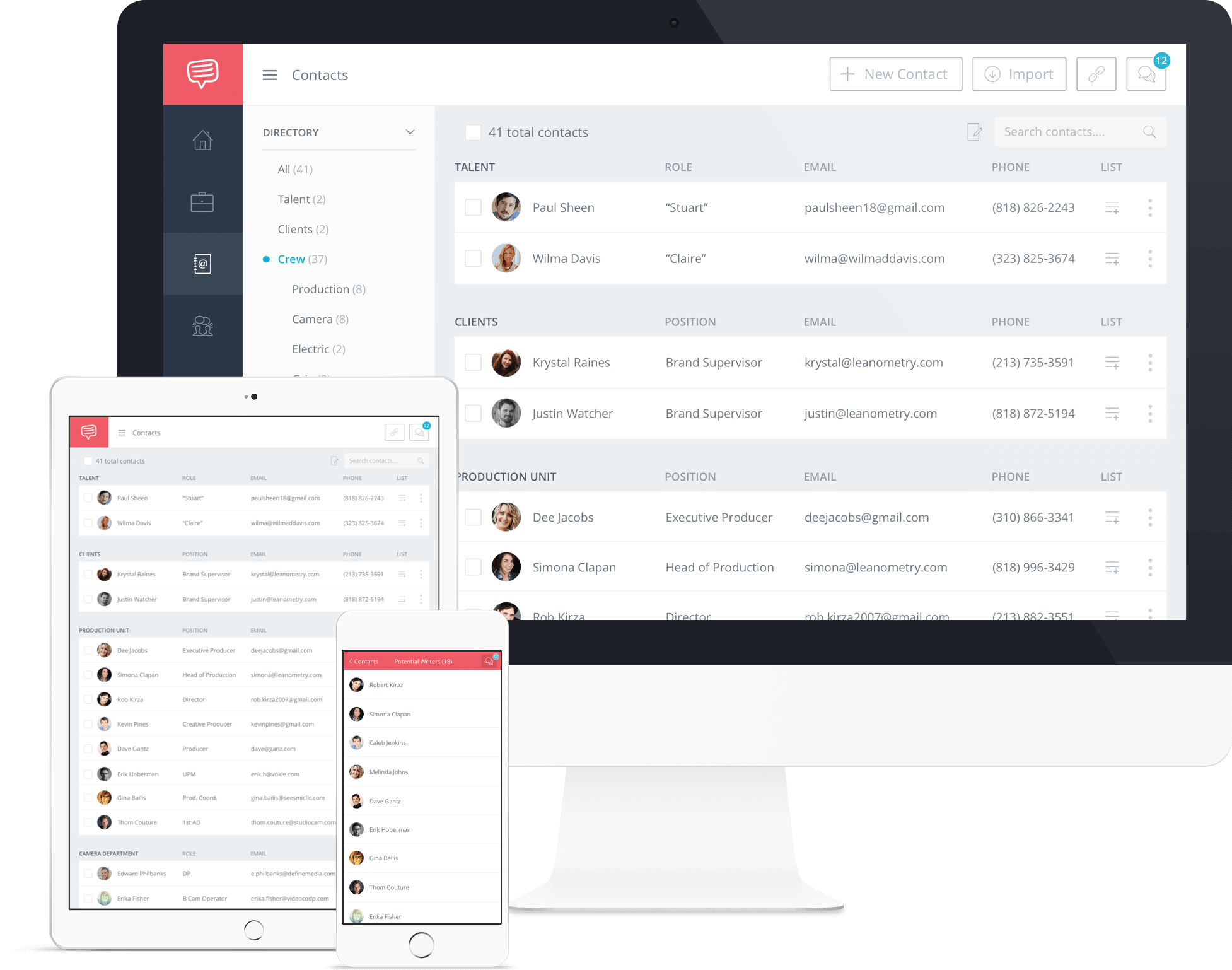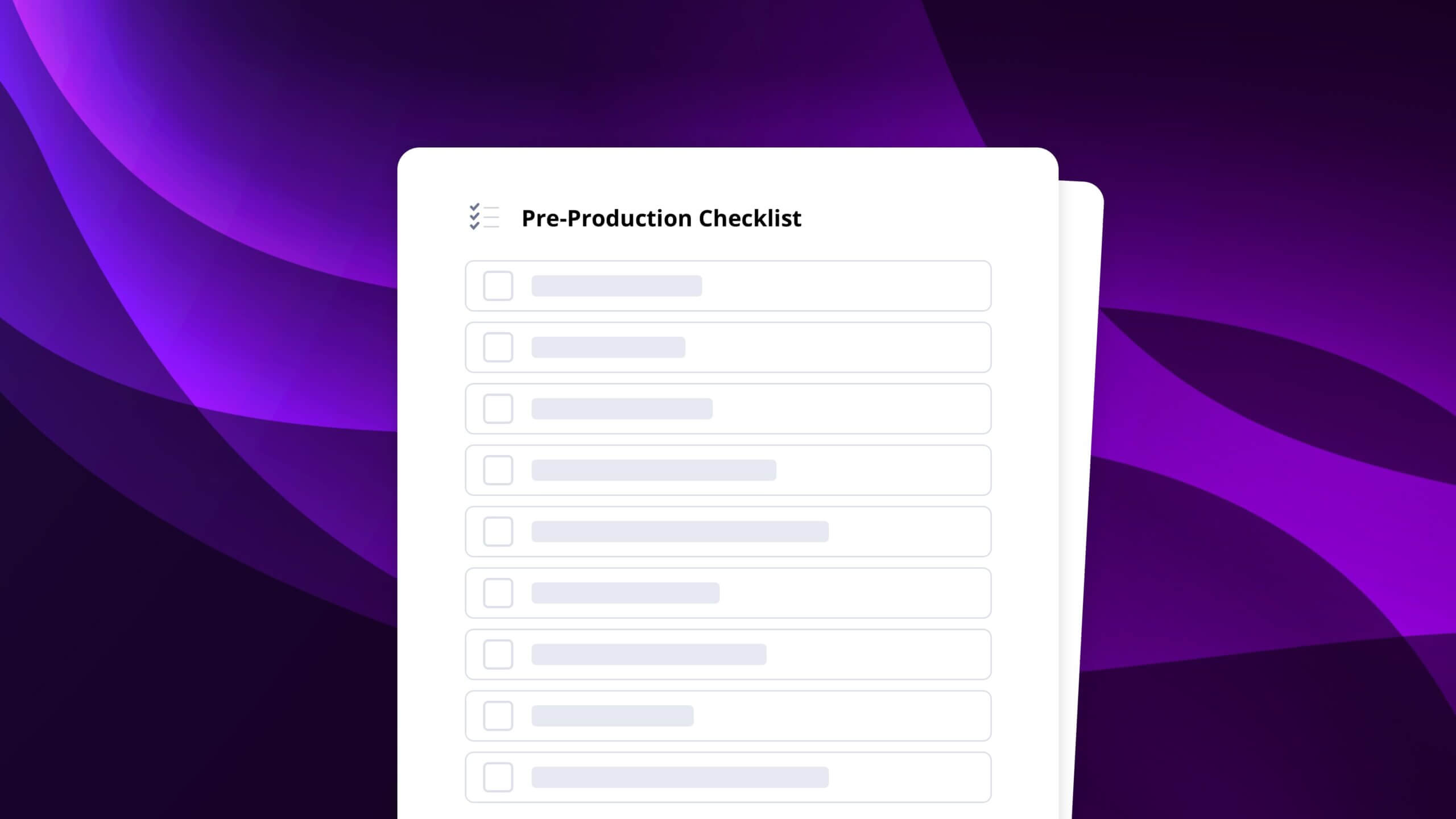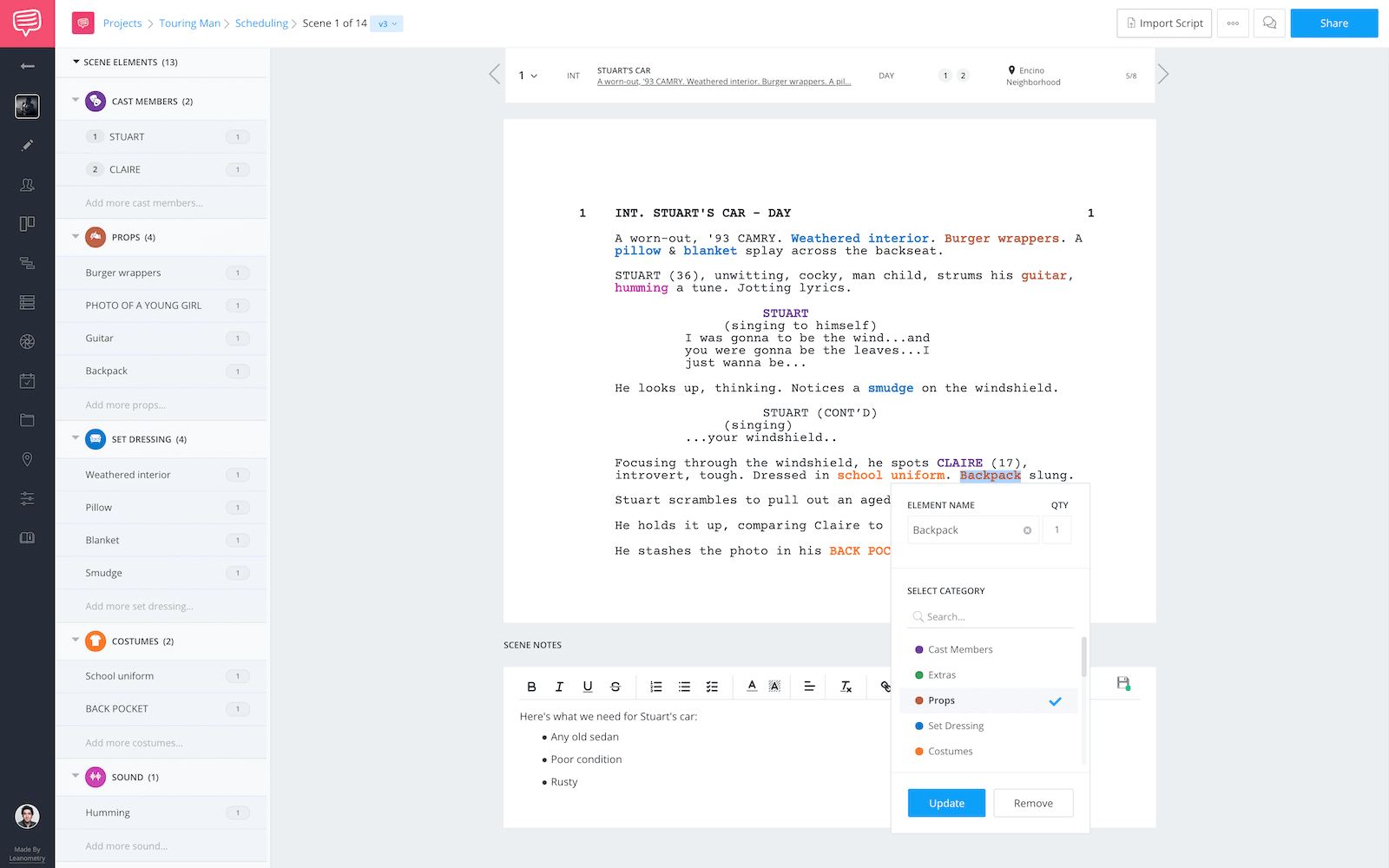Did you finally get the green light? Before hitting the accelerator make sure to grab a pre-production checklist for your upcoming tasks.
Missing one step during pre-production can mean disaster on set, legal issues down the road, and damage to your overall career trajectory as a filmmaker. A thorough film pre production checklist can prevent costly delays and ensure your production runs smoothly.Missing one step during pre-production can mean disaster on set, legal issues down the road, and damage to your overall career trajectory as a filmmaker.
That’s why we put together the ultimate pre-production checklist (including a free checklist you can download and take offline with you).
Let’s jump in!
What is Pre-Production? Elements of Pre-Production in Film Explained
What is Pre Production?
Pre production involves organizing all essential tasks and filmmaking forms before production begins. A comprehensive movie production checklist ensures you account for every task, preventing delays and unforeseen challenges. For instance, imagine organizing a small film set for a kitchen scene. You’d need to confirm the location, plan for props like utensils and fake food, arrange lighting setups, and coordinate actor schedules, all before the first frame is shot. These interconnected tasks highlight the importance of pre-production in ensuring a smooth filming process.
A successful pre-production process addresses all the elements of pre production in film, from logistics to creative planning, to ensure a smooth shoot.
Watch the video below to get an idea of pre-production workflow:StudioBinder pre-production software
You can see there are many steps to pre-production, and how software helps you organize each of those steps with great detail.
It’s an undertaking that requires a lot of moving parts and individual efforts being coordinated precisely, under time and money constraints.
I have a friend who worked on a film with a $2 million dollar budget, but the producers forgot to secure the life rights for the subjects during pre-production.
Guess what?
There is a very slim chance that the film will ever be released.
Pre-production is your chance to take your time and get things right because you won't have that luxury later on when you're under the gun.
What's in the Pre Production Checklist?
The Movie Production Checklist You Can’t Miss
A lot of the items on this list can and should overlap.
Different producers may order things differently, but these 15 basic categories cover everything you need to do before the cameras roll. This checklist is designed to save you valuable time and ensure that no critical steps are overlooked, reducing stress and preventing costly mistakes during production.
We'll quickly dive into each section later and go into why this order works so well. But first here we go.
If you can accomplish these 15 tasks in roughly this order you'll ramp up to production very smoothly.
Now let’s take it step by step.
PRE PRODUCTION CHECKLIST:
FREE Download: Pre Production Checklist

Download your FREE printable pre-production checklist (PDF) below.
Just enter your email address and we'll instantly send it to you!
Lock Shooting Script
1. Lock A Shooting Script Early
While you don't need to lock your shooting script before anything else, it's a great place to start. Most everything your production needs to acquire flows directly from these pages, so the earlier you lock it, the better.
All of the considerations won't be in the script, because writers are not line producers and production coordinators, but producers of any sort still need to script to find all of those hidden elements that will be required
Think about scene like these and how much went into planning them:
StudioBinder Tracking Shots
Was everything that took place in these scenes found in the script?
Absolutely not -but everything in there was inspired by the script.
For example, in the production of the film Whiplash, locking the script early allowed the team to meticulously plan the intense drumming scenes and secure necessary locations well in advance. This ensured a smoother shoot and avoided costly delays due to last-minute changes. Similarly, in Mad Max: Fury Road, locking the script early enabled the team to storyboard complex chase sequences meticulously, ensuring alignment across the art department, stunts, and cinematography.
Script changes will happen mid shoot, but the whole point of the pre production process in film is to head many of those missteps off at the pass.
So start with the script. Lock it in.Related Posts
Finalize the Budget
2. Make a Film Budget
Before you can make any decisions about a movie production, you need to determine how much money you'll have to work with.
- Start with a realistic number: Sometimes you'll have to back into a number, and other times you'll be proposing one. Either way, be honest about what you can achieve within your financial constraints.
- Common challenges for first-time filmmakers:
- Underestimating costs for location permits.
- Overspending on high-end equipment, leaving insufficient funds for critical elements like post-production.
- Practical budgeting tips:
- Allocate at least 10% of your budget as a contingency fund for unexpected expenses.
- Prioritize spending on story-critical elements. For example:
- If your film revolves around a key location, secure it early.
- Save on props by borrowing or renting affordable alternatives.
Whatever the case, always start your budget planning with the script as your guide. A well-thought-out budget ensures every department has the resources needed, preventing costly delays or compromises down the road.
And you'll need a film budget for everything after that.
That's why the script comes first, and budget comes second.
Related Posts
Start your Business
3. Form a Business Entity
Consider this stage more about acquiring cash flow, because you're going to want cash on hand for a lot of steps after this.
Even if you can't start cash flow yet, or don't need to, look at this step as a chance to get some of your other "ducks in a row".
Of course there is a lot more to it than just that.
Do you have all the start paperwork you'll need? Production crew release forms? Contracts? Blank 1099s? Get ahead of the curve on organization here.
This step includes setting up a production office, a familiar part of the pre production process. Your production office may just be a laptop and a binder. It may also be an entire floor of a building. Whatever it is, set it up in step 3.
Learn more about how to start an LLC here.Related Posts
Hire Key Production Heads
4. Hiring Key Production Crew
Let's say you're a producer with a script...
You can't go much farther without at least some key collaborators.
Who do you get first?
The first people you need to get for your production team are the Line Producers, a UPM, or a Production Coordinator. You might also want your 1st AD, but they can come in a bit later.
If you don't already have a director, get one after your line producer.
The director will help you find the cinematographer.
This is a good time to scour your crew contact list for anyone you've worked with in the past that you'd want to bring on. This is why keeping a comprehensive list of all prior crew you've hired is wise. You never know who will be available.
If your project is going to have heavy make-up requirements then that's someone you'd want during this phase. But if not, that hire can wait.
You'll tailor the "who" of this stage to your project. But the pro tip for this stage of preproduction is to get the people you need early on board early.
Related Posts
Break Down the Script
5. Break down the script (with script breakdown software)
Remember that script you locked?
Well now it's time to break it down.
But what do we mean by that exactly?
Breaking down the script helps identify the elements of pre production in film, such as props, costumes, and locations, ensuring everything is prepared. Your screenplay is turning into a series of lists and reports. With a clear script breakdown, you can identify all logistics and filmmaking forms necessary, ensuring nothing is missed.
With those reports, you’ll have a much clearer idea of what you’ll need to budget.
A Brief Primer On The Script Breakdown Pre Production Process:
- Start by assigning each scene a unique color or category based on its elements—locations, props, costumes, or VFX.
- Use breakdown software to highlight these elements directly in the script, so nothing gets overlooked.
- Generate reports for each department—for example, a props report listing every item needed for each scene.
- Cross-check these reports with your budget to identify potential cost overruns early.
A brief primer on the script breakdown pre production process
Imagine that your movie is a meal, and your script is a recipe.
Well now it's time to make the shopping list.
See what a finished script breakdown looks like below:
In a way, you're digesting the 'concept' of your movie and it's turning into real world elements. Now is when you and your team are really starting to figure out how to make a movie.
Save time by using a script breakdown & scheduling software like StudioBinder.
We're now one third of the way into our pre production checklist.
The "first act" of this process is over and we're ready to ramp up our planning to the next stage of pre-production.
Related Posts
Create the Storyboard
6. Turn Your Words Into Images With Storyboard Software
Here we go! The first full creative step since you locked your script. You broke the script into reports. Now you're turning words into images.
What was purely verbal is now visual.
When you make a storyboard, you’re taking a major step towards communicating and realizing the vision of the project.
See how StudioBinder does shot lists and storyboards.
StudioBinder Shot List and Storyboards
Both literally and figuratively. Leveraging the best storyboard software can help you and your visual team achieve this step.
Related Posts
Scout & Secure Locations
7. Tech Scout and Location Scouting Essentials
Location scouting is a process. So you can't cross it off your list before you move to the next step. But you can and should start it now.
There will be something of a give and take between your storyboard process and securing locations.
Real World Example
During the production of La La Land, the filmmakers meticulously scouted locations and discovered the now-iconic Griffith Park scene. They adjusted their storyboard to leverage the natural lighting and aesthetic of the spot, which greatly enhanced the emotional impact of the scene.
In contrast, an indie production faced significant delays and stretched their budget due to a failure to verify location availability early on. This oversight forced last-minute changes, disrupting the entire production schedule. These examples highlight the importance of thorough planning and verification during the location scouting phase.
What you see on your location scouts will inform your boards, and vice versa. We're getting to a point in the pre production checklist where there will be overlap and cross pollination.
Using a tech scout checklist ensures you don't overlook any of all the items that's used for film production, saving time and avoiding logistical issues during filming.
Think it through. Walk it through. Covering all elements of pre production in film during the tech scout ensures that no critical detail is missed. Eventually you'll want to return to the location and do a tech scout:StudioBinder Tech Scout
Pro tip:
Want to learn how to make a movie? You need to master the art of compromise. With individuals, but more so with limitations beyond your control.
For example….
Your director loves a location, but it'll cost a lot more to lock than you budgeted. Can you sacrifice some money elsewhere to secure the dream location?
Or is the location a no-go?
Be prepared to have these conversations and/or make these calls. Sometimes asking up front for a list of deal-breakers from the director is useful.
You don't want to cramp his or her artistic freedom with dollar signs concerns if you don't have to. At the same time, the director needs to accept (and work with you) on fulfilling the budget.
Related Posts
Casting Call: How to Handle Casting During Pre-Production
8. Casting During Pre Production
This is a big one.
Like with many steps, you may have started the casting process already.
Perhaps a star was attached during the development phase, but you're still going to have some parts to audition during the pre production process in film. Ensure your casting call has clear instructions for the roles you’re auditioning, and use online platforms to reach a wide pool of talent.When holding auditions, ensure each actor completes a release form to protect your production and secure the rights to use their performance.
For indie or low-budget productions, consider these tips:
- Leverage local talent: Community theater groups and local acting schools can be excellent sources for finding skilled actors willing to work within your budget.
- Focus on versatility: Look for actors who can take on multiple minor roles or adapt to production challenges.
- Host open auditions: Use social media platforms and casting websites to announce auditions and attract a wider pool of talent.
- Barter or negotiate: Offering reel footage, credits, or networking opportunities can sometimes offset financial limitations.
There are a ton of great casting resources online now. To get you started, explore some of the best free casting websites here.
So let’s get this process going! If you can't find the exact right person for a role you'll want to be able to extend the search.
Related Posts
Rev Up the Art Department with Your Production Designer
9. Art Department Pre Production
This step is a question because in some cases the answer may be “very little.” Say you're prepping a short film that you'll shoot in your apartment –production design tip numero uno when you’re on a tight budget.
Some set dressing. Some props. Nothing out of control.
On the other hand, I once produced a short where we had to build a greenhouse, and a hut in the middle of a desert.
On that project, the art department needed a lot of prep time.
So here is where I'd get my art department's engines revving. Especially if your movie production requires any kind of build.
Permits & Insurance
10. Organize Files and Documents
Act three of our pre production checklist begins here...
This is the home stretch.
By now you've got a lot of the key components in place. Before you go any further, you've got to button things up.
Pull permits for locations.
Buy a production insurance policy.
Consult with legal representatives if necessary.FILM PERMITS
I like to start permitting with plenty of time. Sometimes a location will fall through because of permitting issues. Sometimes the city won't issue a permit without a lot more legwork from you.
You may have a location on your list that requires a fire marshall. You never know until you start working with the permitting office.
If you’re shooting in Los Angeles, you’ll be filing with Film L.A. But do your research wherever you are shooting and find out who you need to permit with.
And trust me…
You should permit your locations. I've been on sets where neighbors complained and if we hadn't been properly permitted, we'd have been shut down. Try explaining that to your Executive Producer. Or studio.FILM INSURANCE
Same goes for insurance. This is one of those things where you'd be shocked at how many productions do without.
Just one more big cost, right?
Better to spend it on a sweet lens pack instead, right??
Wrong.
If something bad happens on your set and you don't have insurance, your problems will go far beyond not getting all your shots done that day.
If nine times out of ten you can get away with it, that’s fine for nine people.
But you don't want to be the tenth.
So button it up. Go legit. Dot your i's and cross your t's.
If you’re not shooting legally then arguably your project can’t happen.
At the very least, you're going to send a message to everyone else on the project. That you are a true professional.
And that’ll serve you in the long term no matter what.
Related Posts
Schedule your Shoot
11. Create a Shooting Schedule (Use Film Scheduling Software)
The vast majority of professional film productions use some form of scheduling software, and this is because it is one of the most valuable tools in film.
Learn what makes it pain-free to create a shooting schedule
This step of pre-production can't happen before you've done everything that came before, as it is all built on top of each other like a home.
Don't move in before you've installed the plumbing.
Ideally, you’d want to lock in your locations and talent before this step because of availability. And you'll want to start the process of building any sets before this too, because that timeline directly affects this step.
Crew Up
12. Fill Out Your Crew Roster
You've got the main players in place (your keys), but now they need support, and we're getting close to DAY ONE. So it's time to crew up.
I like to start by asking production heads if they have anyone they want to bring on. People like the shorthand they have with certain peers.
It's good for the overall morale, it's also good for productivity.
If your keys don't have recommendations, or need some help rounding out the team, then that’s when I go to my production crew contact list.
I might have just the right person.


StudioBinder offers a living contact list that grows with you over time.
There are a lot of great crew hiring resources online like ProductionBeast.
By hook or by crook, you're gonna crew up at step 12.
Related Posts
Create a shot list
13. Create a Shot List
You're so close you can taste it.
Feeling nervous? Check.
Feeling excited? Check.
Feeling hectic? Double Check.
Planning is everything. Whether you’re using a shot list template or a shot list software like StudioBinder, you’ll want to work with your director, AD, and DP to finalize the daily shooting game plan.
Check out the video below to see how a shot list can translate into reality:StudioBinder Shot List | Dutch Angles
Time is going to be your most precious resource during shoot days, and the ticking clock your greatest foe. The more you have set in advance, the more time you have onset to adjust. Because the curveballs are coming.
What is pre production all about?
It’s about finding ways to maximize production time.
RELATED POSTS
Tech Scout: Key Filmmaking Forms to Consider
14. Pre-Production Meeting Checklist
The tech scout is one of the final critical steps in pre-production. It builds upon earlier steps like location scouting, ensuring that every logistical detail is planned and accounted for before filming begins. You and the pertinent crew will travel to the locations, review essential filmmaking forms, and walk through the plan.
This can be super useful for the crew because it's a reconnaissance mission. The soldiers giving the future battlefield a once-over.
So much of a production boils down to logistics. Consider these key questions:
Real-World Example
During the production of The Revenant, detailed tech scouting helped the crew plan for extreme weather conditions and remote locations. Including these steps in your movie production checklist ensures such issues are anticipated.
Think it through. Walk it through.
This day (or days) of tech scouting can also serve as an opportunity for every department to go over needs and concerns. Use tools like tech scout checklist apps or scheduling software to ensure no details are overlooked in your movie production checklist. Prep for your tech scout by checking out our location scouting cheatsheet.gear UP
15. Film Equipment Rentals: A Critical Production Checklist
Each step in the 15-step film pre production checklist feeds into the next, ensuring you're always prepared before moving forward. Last step. Are we ready for "Lights! Camera! Action?"
Well... not without lights and a camera we're not.
Sometimes you'll start the gear or equipment list a lot earlier than this. It can be an evolving process, and you certainly might need to place some items on hold.Cost-Saving Tips For Indie or Low-Budget Productions:
- Rent equipment from local production houses or collaborate with film schools for discounted rentals.
- Opt for multipurpose gear to save costs and reduce logistical complexity.
- For low-budget productions, adding cost-saving strategies to your movie production checklist can help streamline expenses.
- Renting from local production houses or collaborating with film schools can help save on all the items that's used for film production.
Create a Timeline:
- Begin discussions about gear requirements during the script breakdown phase.
- Finalize rental orders right after the tech scout to align with the finalized shot list.
Add Details About Insurance:
- Always secure production insurance for rented equipment and ensure all filmmaking forms are documented properly to avoid risks. This protects against potential damage or loss and ensures you avoid unexpected costs.
Highlight Importance of Communication:
- Schedule a meeting between the Production DesignerDP, Gaffer , and Production Manager after the tech scout to finalize equipment needs and prevent miscommunication.
Practical Example
During an indie film production, the DP adjusted equipment needs after scouting a low-light location. By identifying specific lighting gear requirements, saved on rental costs.
Let's go back to the idea of order of operations once more.
The shot list will inform the walk through at the tech scout. Which will tell you exactly what you need equipment wise.
Each step in the 15 step pre production checklist feeds into the next. That way you don't do anything before you're ready to. You go into each phase of preproduction, and ultimately production itself, as prepared as possible.
FREE Download: Pre Production Checklist



Download your FREE printable pre-production checklist (PDF) below.
Just enter your email address and we'll instantly send it to you!
up Next
Welcome to StudioBinder
If you're interested in pre-production, it is either because you have a project ready to be produced, or you're building a career as a filmmaker or producer.
Either way, you've come to the right place.
Video editors use NLE's, cinematographers have their favorite lenses and camera bodies, gaffers have their favorite lights - you have StudioBinder.
Get started for free and see how we can help you bring your vision to life.
Create Your FREE StudioBinder Account →
Project management for video creatives. Tasks, file sharing, calendars and more.
Manage video production timelines, tasks, storyboards, shot lists, breakdowns, call sheets. Made for video creatives, new media and film.
Did You Know
If your film scheduling software supports it, we recommend using an "auto-day break" feature which will automatically add a day break after a number of pages of your choosing. This saves a good chunk of time.
A general rule for a dialogue-heavy indie film is to add a day break every 3-5 pages, but you can set it to anything you like.

